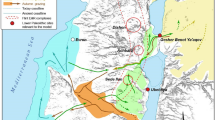Abstract
Eight oak galls caused by cynipid wasps and preserved by the eruption of Mt. Vesuvius at Herculaneum, Italy, provide tangible clues to the significance of galls in early human culture. The external and internal appearances of the galls are described. Remnants of insects were found in two of the specimens. It is suggested that all but one of the galls were caused by the cynipidAdleria kollari. Probable uses of the galls are discussed; it is concluded that the galls were likely sold for use in medicines.
Similar content being viewed by others
Literature Cited
Forbes, R. J. 1964. Studies in ancient technology, 4. Brill, Leiden.
Houard, C. 1908. Les zoocécidies des plantes d’Europe et du Bassin de la Méditerranée. Vol. 1. Librarie Scientifique A. Hermann, Paris.
Jashemski, W. F. 1979. The gardens of Pompeii, Herculaneum and the villas destroyed by Vesuvius. Caratzas Brothers, New Rochelle, NY.
Kieffer, J. J. 1901. Synopsis des zoocécidies d’Europe. Ann. Soc. Entomol. France 70: 233–579.
Lamb, M. C. 1925. Leather dressing including dyeing, staining and finishing. Anglo-American Technical Co., London.
Larew, H. G. 1986. The fossil gall record: a brief summary. Proc. Entomol. Soc. Wash. 88: 385–388.
Lehner, S. 1926. Ink manufacture. English edition; C. A. Mitchell, ed. Scott, Greenwood and Son, London.
Mau, A. 1902. Pompeii: its life and art. 2nd ed. F. A. Kelsey, Trans. Macmillan, New York.
Meyer, F. G. 1980. Carbonized food plants of Pompeii, Herculaneum, and the Villa at Torre Annunziata. Econ. Bot. 34: 401–437.
Mitchell, C. A., and T. C. Hepworth. 1904. Inks: their composition and manufacture. Charles Griffin, London.
Moeller, W. 1976. The wool trade of ancient Pompeii. Brill, Leiden.
Pliny the Elder. 1966. Natural history in ten volumes. Vol. 7. W. H. S. Jones, Trans. Harvard University Press, Cambridge, MA.
— 1968. Natural history in ten volumes. Vol. 4. H. Rackham, Trans. Harvard University Press, Cambridge, MA.
Ricciardi, M., and G. G. Aprile. 1978. Preliminary data on the floristic components of some carbonized plant remains found in the archaeological area of Oplontis near Naples. Ann. Fac. Sci. Agrar. Univ. Napoli in Portici, Ser. 4, 12: 204–212.
Villon, A. M. 1901. Practical treatise on the leather industry. F. T. Addyman, Trans. Scott and Greenwood, London.
Zangheri, P. 1976. Flora Italica. Cedam, Padova.
Author information
Authors and Affiliations
Rights and permissions
About this article
Cite this article
Larew, H.G. Oak galls preserved by the eruption of mount vesuvius in A.D. 79, and their probable use. Econ Bot 41, 33–40 (1987). https://doi.org/10.1007/BF02859343
Received:
Accepted:
Issue Date:
DOI: https://doi.org/10.1007/BF02859343




